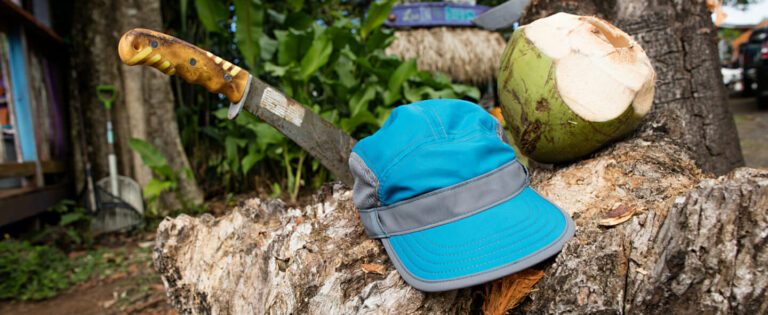A climbing rope is a tool. It is inevitable that it will break at some point. However, you can do a lot to prolong the life of your climbing rope by following a few tips.
In this article, we explain what you can do to reduce rope wear and how to maintain and store it properly so that you can enjoy it for as long as possible. We also explain when your rope’s time is up and how to recognise it.
How can I reduce rope wear?
Due to the way they are woven, climbing ropes tend to get tangled. Some begin to do so at random, while others never even start. What all ropes have in common, is that you can cause them to become entangled, for example, when you roll them into a loop (as is done with cables) or unwind them incorrectly after purchase. To avoid or delay your rope from getting tangled, you should repeatedly pull it through the diverter. As a result, the rope is able to hang loose. If the lead climber is back on ground, you then need to pull on the loose end and not the end of the belayer. This takes a bit longer, but is much healthier for the rope.
Lowering also puts a lot of pressure on the rope, which is why slow and even lowering is healthier for the rope than fast and jerky movements. The same principles apply for top rope climbing ropes. If you love top rope climbing, then we recommend a rope with a thick sheath percentage.
Frequent falls and route settings are especially unhealthy for the first 2-4 metres of a rope. Therefore, you should swap the ends around every now and then, so that both ends of the rope are equally used and worn.
It is also important not to expose the rope to too much unnecessary sunlight, as the material then becomes brittle.
Actually, the worst things that your rope can come into contact with are sharp edges. As a result, you should always avoid letting your rope run over sharp edges, or even to fall in such a way that the main load for the rope is on an edge.
What also plays a huge part in rope wear, is how dirty it gets. That’s why you should take care to keep your rope as clean as possible. The best way to do this is with a rope bag – which is now available in a wide variety of designs: for indoor use, lightweight, robust, comfortable carrying system for long ascents, with plenty of space, etc.
- Avoid sharp corners at all costs
- Aim for even lowering
- Alternate rope ends for even wearing
- Repeatedly pull the rope through the diverter
- Keep rope as clean as possible
- Use a rope bag
- Do not store in direct sunlight or damp conditions
How to wash your rope correctly
But even with the greatest care, a rope eventually becomes dirty and stiff when used on the crag. To make it shine again, the best thing to do is to wash your climbing rope! To do this, simply run lukewarm water into the bathtub and lower the rope into it in large loops. Carefully scrub everything with synthetic detergent and a soft brush and then dry in a cool, dark place – never hang it up to dry, just let it lie.
Note the washing process can wash out waterproof coatings and lubricating substances in the rope. This can make the rope more rigid and less water-repellent after washing. If you want to prevent this, you can also clean individual areas with a brush and lukewarm water instead of washing the entire rope.
If you don’t want to do it by hand, you can also put your rope in an old pillowcase and put it in the washing machine. Wash at 30° and on a gentle programme (wool). But be careful: never spin dry your rope or put it in the tumble dryer!
- Lukewarm water, synthetic detergent, possibly with a special brush
- Maximum 30°C, wool programme
- Do not spin dry
- Do not put in tumble dryer!
- Leave to dry lying, not hanging
- Dry in a cool, dark place
- Wait until rope is thoroughly dried
How to store a rope correctly
Similar to the process of drying after washing your climbing rope, the rope should always be stored in a cool, dark and dry place – preferably lying down, not hanging. If there is not enough space for this, it is best to wind it into wide loops or wind a cord around the entire rope and hang it from this. Under no circumstances should the rope hang from only one of its loops! This will stress the rope only at this one point and make it brittle.
It is especially important that the rope is not stored near chemicals (petrol) or acid (car batteries). So that means neither on a battery, nor directly above it. The same applies to UV radiation, as this makes the material porous and will speed up rope wear.
- Store in a cool, dry, dark place.
- Store laying, not hanging.
- If hung up, then not on one loop but on many, or add an accessory cord.
- Must be kept far away from acid, UV radiation and sharp corners!
Checking the rope
A rope should be subjected to regular extensive check ups. How often these checks have to be done, depends on how often the rope is used. Has it been used a lot recently, has it been exposed to particularly large loads, such as high falls or a rope running over edges or cracks? Then you should definitely take a closer look at your rope as part of your climbing rope maintenance.
To do this, pull metre by metre through your fingers and look and feel for any thickening, thin spots or damage in the sheath. If the sheath is a little roughened or individual threads are sticking out, this is no reason to replace the rope. However, if you see the core of the rope, it is time to act. In case of doubt, our customer service will be happy to help you with the assessment.
But even you find a spot where the sheath is open or the rope is very thin, this does not necessarily mean that you have to throw away the entire rope. If the damage is at the ends, but the rest is still in perfect condition. In this case, it is sufficient to measure a suitable distance from the damaged part and cut the rope at this point (the rope should be in perfect condition here). To do this, cut the rope with a rope cutter then take a piece of tape and wrap it firmly around the end of the rope, precisely at the edge. A rope cutter is a kind of soldering iron that melts the rope as it is cut. Just ask at your climbing centre, they will surely have one. If you don’t have a rope cutter, you can also use a very sharp knife.
When you have finished cutting, just fuse the individual strands (sheath and core) together using a lighter and, voila, your „new“ old rope is ready. Be careful with bicolour ropes or ropes with a centre marking; it makes sense to cut off a piece of equal length on both sides. It is also important to write down how many metres have been cut off in order to be able to estimate at a later date whether the length is still sufficient for a particular route. The piece of tape at the end of the rope is very useful for noting down the new length.
- Metre by metre, checking both by sight and touch
- Look out for: thickening, thin spots, damaged sheath.
- If rope is shortened: note new length, if necessary re-mark centre (please use additional resources to achieve this).
Lifespan of ropes
Each manufacturer makes their own statements regarding the lifespan of their ropes. Mammut and Edelrid, for example, estimate a lifespan of ten years if the rope has hardly been used. However, with good rope care and little use, a rope will easily last three to six years. With frequent use and numerous falls, it is often time for a new rope much sooner, relegating an old one for use only in top rope climbing. Here you should strongly consider the respective manufacturer’s specifications.
A rope should be replaced whenever any of the following points apply:
- It came into contact with chemicals – especially acids
- You can see the sheath is damaged and the core is showing
- The sheath is extremely worn and exceptionally furry
- The sheath has moved a lot from its original position
- The rope is very deformed
- It has had to withstand extreme stress (fall factor 1, fall over edge, rockfall, hit with ice axe)
- It is extremely dirty (tar, oil, grease)
- It has melted spots caused by heat or friction
And in case you want to build something creative from your old rope, why not make a doormat, a trivet or a purse. Or maybe the kids would love to climb in a spider web?
If you have any further questions, our customer service team are happy to help. You can contact our customer service during the week from 9 a.m. till 4 p.m. and can be reached by phone at 03 33 33 67058 or via e-mail.
There’s quite a lot happening in the world of climbing and outdoor activities. New products are developed, existing ones are revised or improved and we are learning many new things on a daily basis. And of course, we want to share our knowledge with our customers. Therefore we regularly revise the products in our base camp. So don’t be surprised if a few things have changed after a couple of months. This post was last updated on 13.01.2023.








